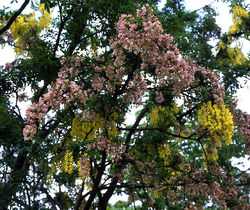Graft-chimaera

In horticulture, a graft-chimaera may arise in grafting at the point of contact between rootstock and scion and will have properties intermediate to those of its "parents". A graft-chimaera is not a true hybrid but a mixture of cells, each with the genotype of one of its "parents": it is a chimaera. Hence, the once widely used term "graft-hybrid" is not descriptive; it is now frowned upon.
Propagation is by cloning only. In practice graft-chimaeras are not noted for their stability and may easily revert to one of the "parents".
Nomenclature
Article 21 of the ICNCP stipulates that a graft-chimaera can be indicated either by
- a formula: the names of both "parents", in alphabetical order, joined by the plus sign "+":
- Crataegus + Mespilus
- a name:
- if the "parents" belong to different genera a name may be formed by joining part of one generic name to the whole of the other generic name. This name must not be identical to a generic name published under the ICBN. For example +Crataegomespilus is the name for the graft-chimaera which may also be indicated by the formula Crataegus + Mespilus. This name is clearly different from ×Crataemespilus, the name under the ICBN for the true hybrid between Crataegus and Mespilus, which can also be designated by the formula Crataegus × Mespilus.
- if both "parents" belong to the same genus the graft-chimaera may be given a cultivar name. For example Syringa 'Correlata' is a graft-chimaera involving Syringa vulgaris (common lilac) and Syringa ×chinensis (Rouen lilac, which is itself a hybrid between S. vulgaris and S. laciniata). No plus sign is used, because both "parents" belong to the genus Syringa.
A graft-chimaera cannot have a species name, because it is simultaneously two species. Although +Laburnocytisus 'Adamii', for example, is sometimes seen written as if it were a species (+Laburnocytisus adamii), this is incorrect.
In Darwin's works
Charles Darwin «The Variation of Animals and Plants Under Domestication», 1868 г.:
I will therefore give all the facts which I have been able to collect on the formation of hybrids between distinct species or varieties, without the intervention of the sexual organs. For if, as I am now convinced, this is possible, it is a most important fact, which will sooner or later change the views held by physiologists with respect to sexual reproduction. A sufficient body of facts will afterwards be adduced, showing that the segregation or separation of the characters of the two parent-forms by bud-variation, as in the case of Cytisus adami, is not an unusual though a striking phenomenon. We shall further see that a whole bud may thus revert, or only half, or some smaller segment.